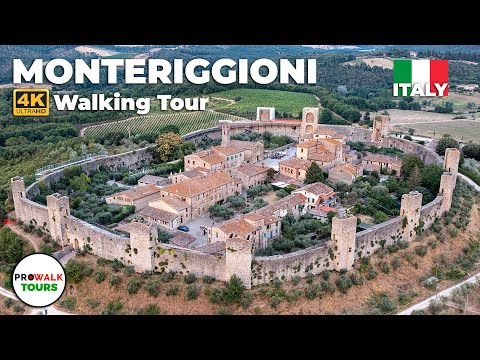Monteriggioni, Italy Walking Tour - 4K - with Captions

Welcome to Monteriggioni, a pretty medieval town in the Italian region of Tuscany. We start our walk at Porta Franca, otherwise known as Porta Romea, which was built as one of the main entrances to the city set into the medieval walls. The gate faces the direction of Rome and probably once had a drawbridge. This square is named after the renowned poet Dante Alighieri because he references Monteriggioni in his seminal work, The Divine Comedy.
In fact, the poet uses the turrets of the town to create a terrifying image of a ring of giants that surround the infernal abyss. He writes, “As with circling round / Of turrets, Monteriggioni crowns his walls; / E’en thus the shore, encompassing the abyss, / Was turreted with giants, half their length / Uprearing, horrible, whom Jove from heaven / Yet threatens, when his muttering thunder rolls.” The church of Santa Maria dates back to the 13th century. The facade is very plain, with a Gothic arched entrance and a small round window. It is built in the typical Romanesque-Gothic style prevalent at the time.
It has a simple plan with a single nave and an apse. The church was once the headquarters for a canonical community. Monteriggioni was originally built as a walled fortress by the Sienese between 1213 and 1219. Ooooh..what a nice ebike! Who's could that be?
The town was originally constructed as a defensive fortification during the Sienese wars with Florence, their historic rival. This is the ticket office where you can buy a ticket to walk along the fortress walls. Monteriggioni was built in a strategic position along the Via Cassia running through two valleys, the Val d’Elsa and the Val Staggia.
Mentioned by Dante in the Divine Comedy, the walls of Monteriggioni are one of the more prestigious and original vestiges of Tuscan medieval architecture. Built around 1214 by the Sienese, the outer perimeter, initially topped by crenellation, unfurls for 560 meters, with fourteen towers placed at intervals. The road that passes straight through Monteriggioni is part of the Via Francigena, an ancient road and pilgrimage route running from the cathedral city of Canterbury in England, through France and Switzerland, to Rome and then to Apulia, Italy. It was known in Italy as the "Via Francigena" ("the road that comes from France") or the "Via Romea Francigena" ("the road to Rome that comes from France"). The crenellations on each tower were taken down in the 16th century and rebuilt in the 1920s and 1930s. The grey stone of the walls is a limestone quarried on the Montagnola range to the west.
I stayed at an Airbnb that was located in the patch of trees at the center of the screen. Monteriggioni was originally only built to house some soldiers, officers and their families, rather than as a town with civilians, craftspeople and farmers. Siena felt the need to build a stronghold from scratch which would face Florence in a threatening way. A hill called Monte Ala was bought by the noblemen of Staggia and the castle of Monteriggioni was built beginning in 1213. It was called Mons Regionis, and it was built on the ruins of a Lombard farm. Thanks to its mighty defensive walls, Monteriggioni was able to withstand multiple attacks from the Florentines.
In the Middle Ages, Via Francigena was the major pilgrimage route to Rome from the north. The route was first documented as the "Lombard Way", and was first called the Iter Francorum (the "Frankish Route") in the Itinerarium sancti Willibaldi of 725. The name Via Francigena is first mentioned in the Actum Clusio, a parchment of 876 in the Abbey of San Salvatore at Monte Amiata. The origins of the route can be traced back to the Lombards who, during their reign in Italy (568-774), found it necessary to connect regions of Tuscia and Padania.
Via Francingena saw its maximum glory between the 9th and 13th century when it became a paramount axis for a communication network. The route not only served as a path for pilgrims but it also acted as a trade route. The 1600 km route was lined with hospitals, taverns, inns and monasteries where food and shelter could be sought. This piazza was only named after Dante Alighieri this year, as it is the 700th anniversary of the poet’s death. It was previously called Piazza Roma. During the years of wars with the Florentines, the walls were said to be surrounded by coal pits set on fire to repel attackers. In 1224, the Florentine Guelphs (a political faction) entered Monteriggioni but were captured and killed by the Ghibellines (the opposing faction) assisted by the Sienese. The walls were damaged and Siena had no help or loyalty from their unpaid soldiers due to excessive spending.
In 1254, the Guelphs again besieged Monteriggioni which initially resisted the violent attacks. However, the German garrison manning the castle had been poorly paid and so accepted a bribe to hand over the fort. There is a museum in the building. Entrance to the museum is included with the castle walls ticket. After the 1254 siege, Siena lost Monteriggioni. Sienna is only 20 km (13 miles) to the south.
The peak of Sienese power came in 1260 when they won the battle of Montaperti. The Sienese then suffered a terrible loss at the Battle of Colle in 1269, also mentioned by Dante in his Divine Comedy. We are currently walking down the main street of the town which leads to the second of the two entrance gates, Porta Fiorentina (or Porta San Giovanni). As the name suggests, this gate faces towards Florence.
We will now use our same castle wall ticket to walk along a short section of this north wall. In the mid 14th century, Monteriggioni was also having to defend itself from criminals that roamed the area. Between 1400 and 1500 the walls were strengthened to better resist the blows of the attacking artillery. From this view you can see the other two streets in town, one on either side of the park. In 1526, the Florentines besieged Monteriggioni with 2000 infantry and 500 horsemen, bombarding the walls with artillery. Monteriggioni resisted and, on 25 July of that same year, in the battle of Camollia, the Sienese defeated the papal army allied with the Florentines.
The main square is surrounded by Renaissance-style houses that would have once been owned by noble families and wealthy merchants. Off the main square are houses and gardens, which once would have been a vital lifeline for growing fruit and vegetables when the fort was under siege. In 1554, the Sienese put Monteriggioni under the control of captain Giovannino Zeti, who had been exiled from Florence. But On April 27, 1554, Monteriggioni was betrayed.
In an act of reconciliation with the Florentine Medici, Zeti simply handed over the keys of the town without a fight. For historians, this is an important episode that marks the end of the reign of city-states in Italy. Under the Florentines, Cosimo I de Medici took control of the territory and some of the inhabitants of Monteriggioni were taken as slaves to Florence. In the 18th century, Monteriggioni came under the control of the Griccioli family, which still owns some structures inside the walls and in the surrounding countryside. The municipality of Monteriggioni now has just over 10,000 inhabitants.
We will now take a walk around the outer perimeter and then back to the piazza through the Porta Romana. Have you been to Monteriggioni? What did you think? Where did you stay while you were here? Siena makes a great home base while exploring Tuscany. Siena is just a 20 minute drive to the south of Monteriggioni while San Gimignano is about 20 minutes north. From Siena, Arezzo is about an hour to the east while Volterra is about an hour to the west.
While the towns are all charming and interesting to visit, my favorite part of Tuscany is driving around the beautiful country side. While in the area, I also explored many side roads and trails on my bike which was one of my favorite parts of the trip. There is a visitor parking lot to the right, but there is also another one just up the road across the street from the gate.
There are concerts each night during the summer here in the Piazza. Thanks for watching!
2022-01-13 07:43


